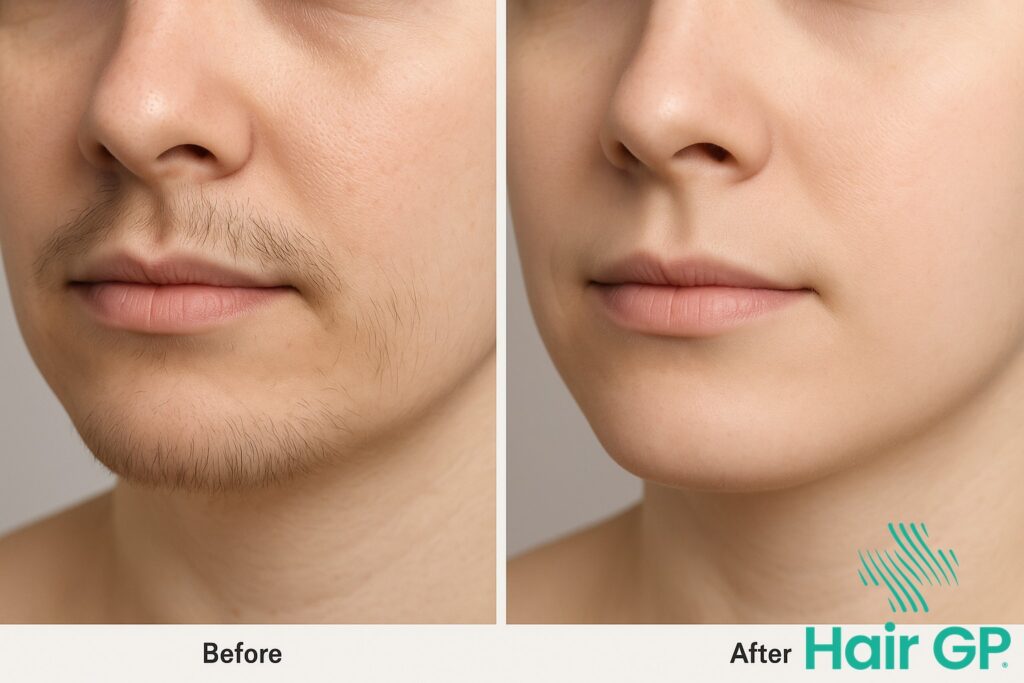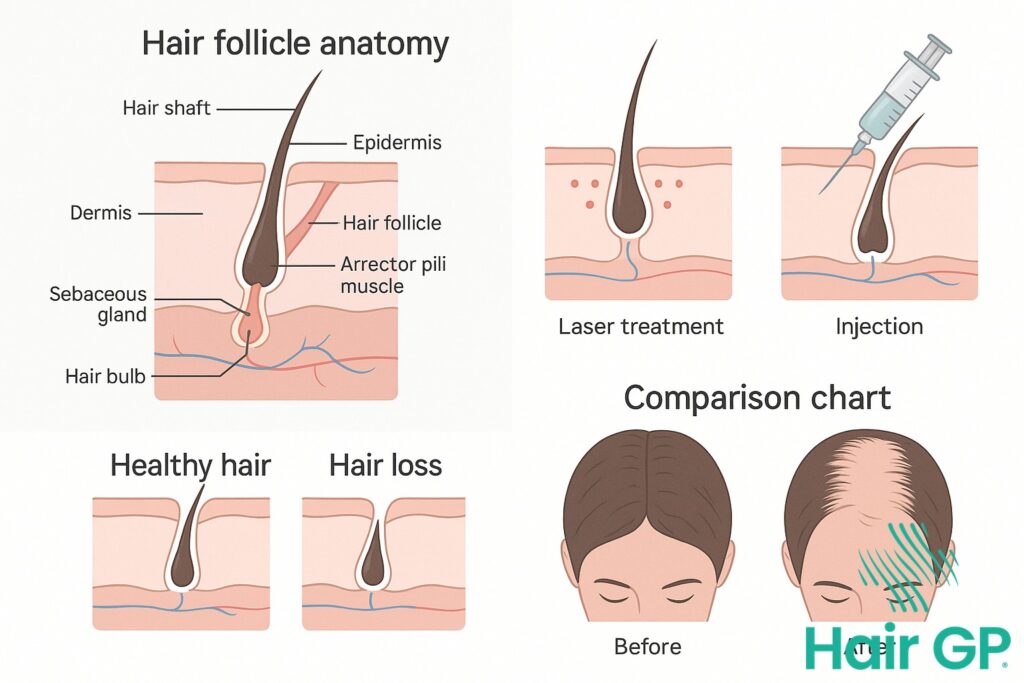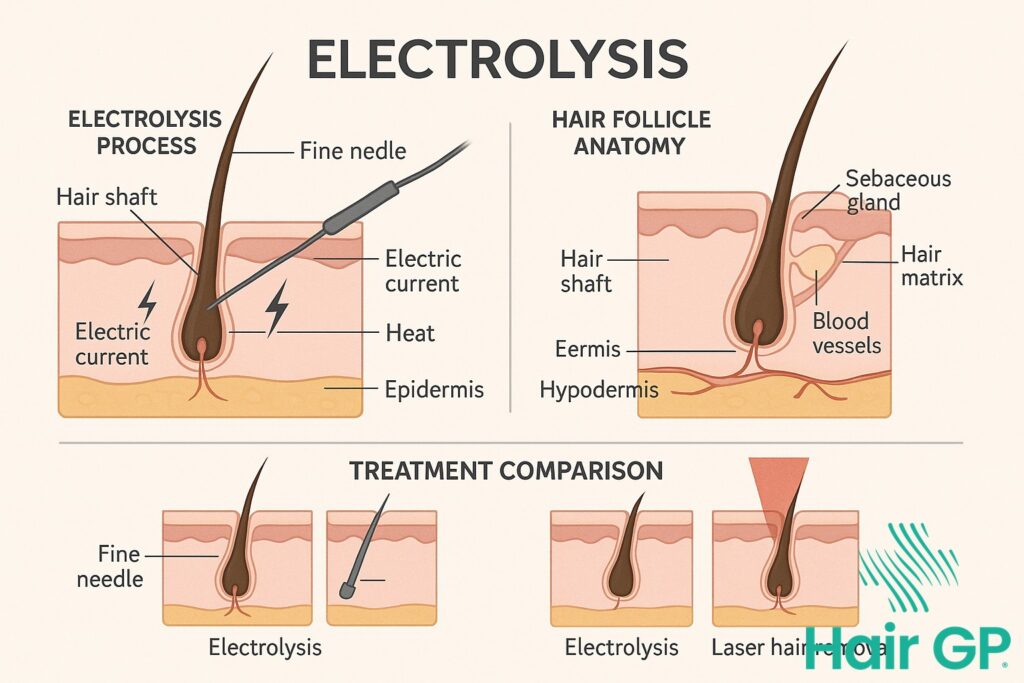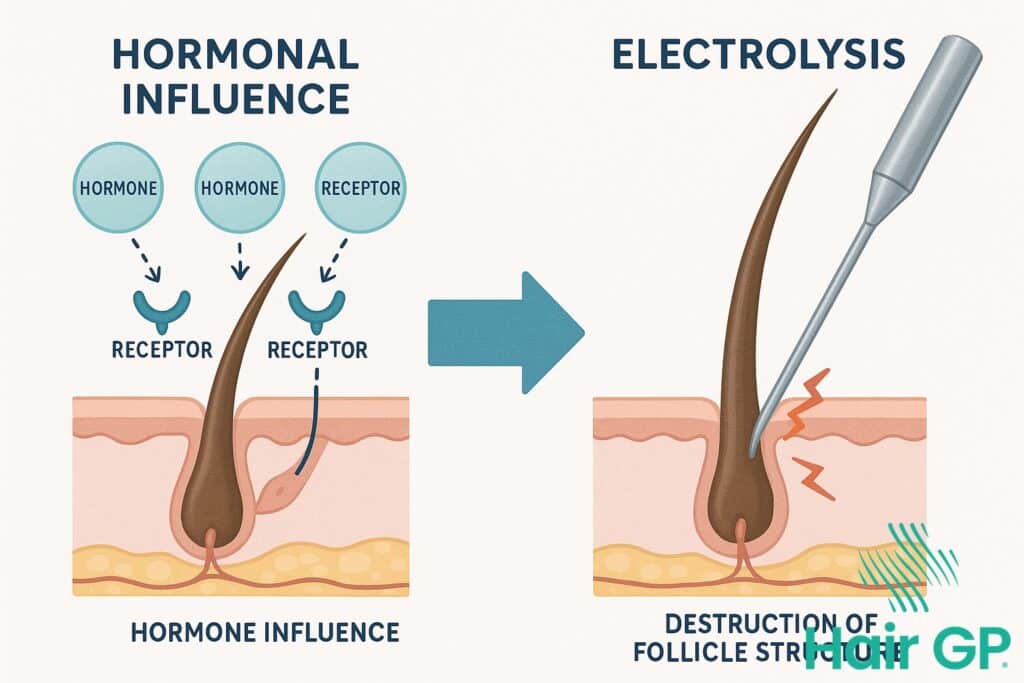Introduction
If you’re living with hirsutism, you understand how excessive hair growth can affect every aspect of your daily life. The constant battle against unwanted hair growth on your face, neck, and body isn’t just about aesthetics – it’s about reclaiming your confidence and sense of self. Whether caused by polycystic ovary syndrome, hormonal imbalances, or genetic factors, hirsutism impacts millions of women worldwide, often leading to anxiety, social withdrawal, and diminished self-esteem.
Living with hirsutism how electrolysis can restore confidence and control is a journey many women are discovering, as this permanent hair removal method offers what temporary solutions cannot: lasting freedom from unwanted hair. Unlike other treatments that merely manage symptoms, electrolysis addresses the root cause by permanently destroying hair follicles, regardless of hair colour or skin type.
This comprehensive guide explores everything you need to know about using electrolysis to manage hirsutism effectively. We’ll examine the science behind this proven treatment, compare it with laser therapy, and discuss how to address underlying hormonal factors. You’ll discover specialised approaches for PCOS-related hair growth, realistic treatment timelines, and strategies for managing both the physical and emotional aspects of your journey towards lasting confidence.
Key Takeaways – TL/DR
- Electrolysis provides permanent hair removal by destroying hair follicles individually with electrical current
- Treatment is effective for all hair colors and skin types, unlike laser hair removal
- Most patients require 12-18 sessions over several months for optimal results
- Combining electrolysis with hormonal management improves long-term outcomes for PCOS and hirsutism
Understanding Excessive Hair Growth and Its Impact
Understanding the mechanisms behind excessive hair growth helps demystify this challenging condition whilst validating the profound emotional impact it creates. Hirsutism results from complex interactions between hormones, genetics, and metabolic factors, affecting both physical appearance and psychological wellbeing in ways that extend far beyond the visible symptoms.
Common Causes of Hirsutism in Women
The most prevalent trigger for excess hair growth is polycystic ovary syndrome (PCOS), affecting approximately 10% of women of reproductive age[1]. Women with PCOS experience elevated male hormones (androgens), which stimulate terminal hair follicles in typically male-pattern areas including the face, chest, and abdomen. This hormonal imbalance disrupts the normal hair growth cycle, transforming fine vellus hairs into thick, dark terminal hairs that become increasingly noticeable.
Beyond polycystic ovary syndrome, PCOS represents just one cause of abnormal hair growth. Congenital adrenal hyperplasia, though less common, triggers excess hair growth through enzyme deficiencies that lead to androgen overproduction[2]. Certain medications, including anabolic steroids, testosterone supplements, and some anticonvulsants, can also stimulate unwanted hair growth patterns. Interestingly, idiopathic hirsutism accounts for a significant proportion of cases where women experience excessive hair growth despite normal hormone levels, suggesting heightened sensitivity of hair follicles to circulating androgens.
Genetic predisposition plays a crucial role, with family history strongly influencing both the likelihood and severity of hirsutism. Women from Mediterranean, Middle Eastern, and South Asian backgrounds often experience more pronounced symptoms due to genetic variations in androgen receptor sensitivity. Understanding these diverse causes empowers affected women to seek appropriate hormonal testing and targeted PCOS treatment options, moving beyond temporary cosmetic solutions to address underlying imbalances.
How Electrolysis Works: The Permanent Solution
Electrolysis stands as the only FDA-approved permanent hair removal method, offering hope to those battling hirsutism. Unlike temporary solutions, this treatment targets each hair follicle individually with precision, using electrical current to permanently eliminate the hair follicle’s ability to produce new growth. For women with hormone-driven excessive hair growth, understanding how electrolysis works reveals why it’s uniquely effective where other treatments fall short.
The Science Behind Permanent Hair Removal
Electrolysis involves inserting a fine probe into the hair follicle, delivering targeted energy to destroy hair follicles at their root. Three distinct methods achieve this permanent solution: thermolysis uses high-frequency alternating current to generate heat, galvanic employs direct electric current to create a chemical reaction, and blend combines both approaches for enhanced effectiveness. Each hair must be treated individually during its active growth phase, which explains why multiple treatment sessions are necessary.
The electrical current specifically targets and destroys growth cells within the follicle’s dermal papilla, preventing any future hair production. This precision makes electrolysis superior to alternatives like laser treatments, particularly for hirsutism patients whose hormonal fluctuations can trigger new hair growth in untreated follicles. While electrolysis vs laser comparisons often arise, only electrolysis guarantees permanent removal regardless of hair colour, skin tone, or hormonal status – crucial factors for those managing hirsutism’s unpredictable patterns.
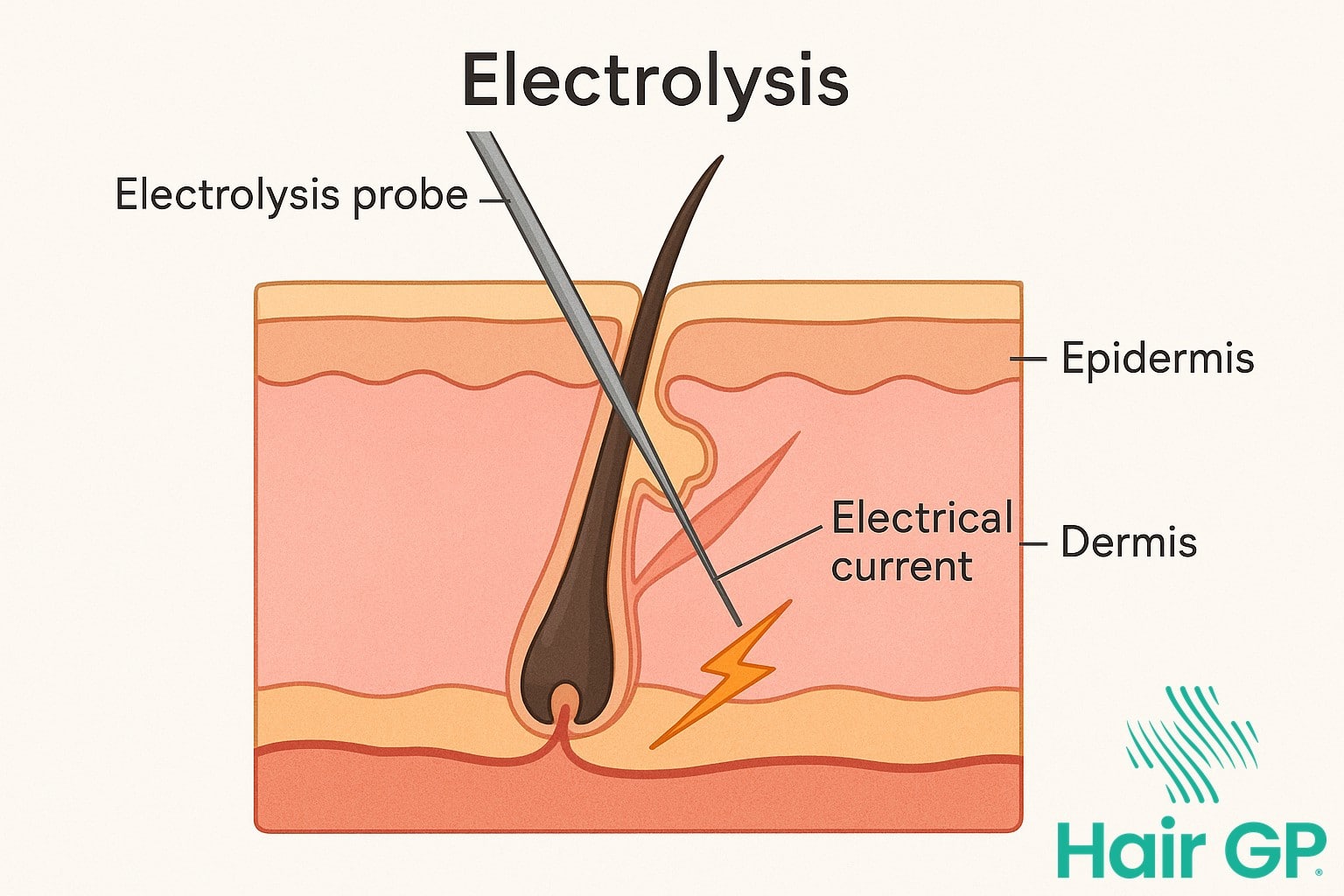
Facial Hair Management: Targeting Problem Areas
Facial hair growth remains one of the most visible symptoms of hirsutism, significantly impacting aesthetic confidence and daily social interactions. The upper lip, chin, and neck are areas typically affected, creating dark, coarse hair in regions where men typically grow hair naturally. These small areas require precise, targeted treatment approaches that electrolysis can uniquely provide through its individualised follicle destruction method.
Treatment protocols for facial hair vary depending on hair density and skin sensitivity. The upper lip often requires gentler settings initially, whilst chin areas may tolerate more intensive sessions. Understanding facial hair causes, whether hormonal or genetic, helps practitioners customise treatment plans effectively. Sessions typically last 15-30 minutes for small areas, making them manageable even for busy schedules.
Proper skincare post-treatment becomes essential when treating delicate facial skin. Gentle cleansing, avoiding harsh products, and protecting treated areas from sun exposure ensures optimal healing. Many clients report improved social confidence after just a few sessions, as visible symptoms diminish and the psychological burden of daily hair management lifts. This social impact reduction often proves as valuable as the physical results themselves.
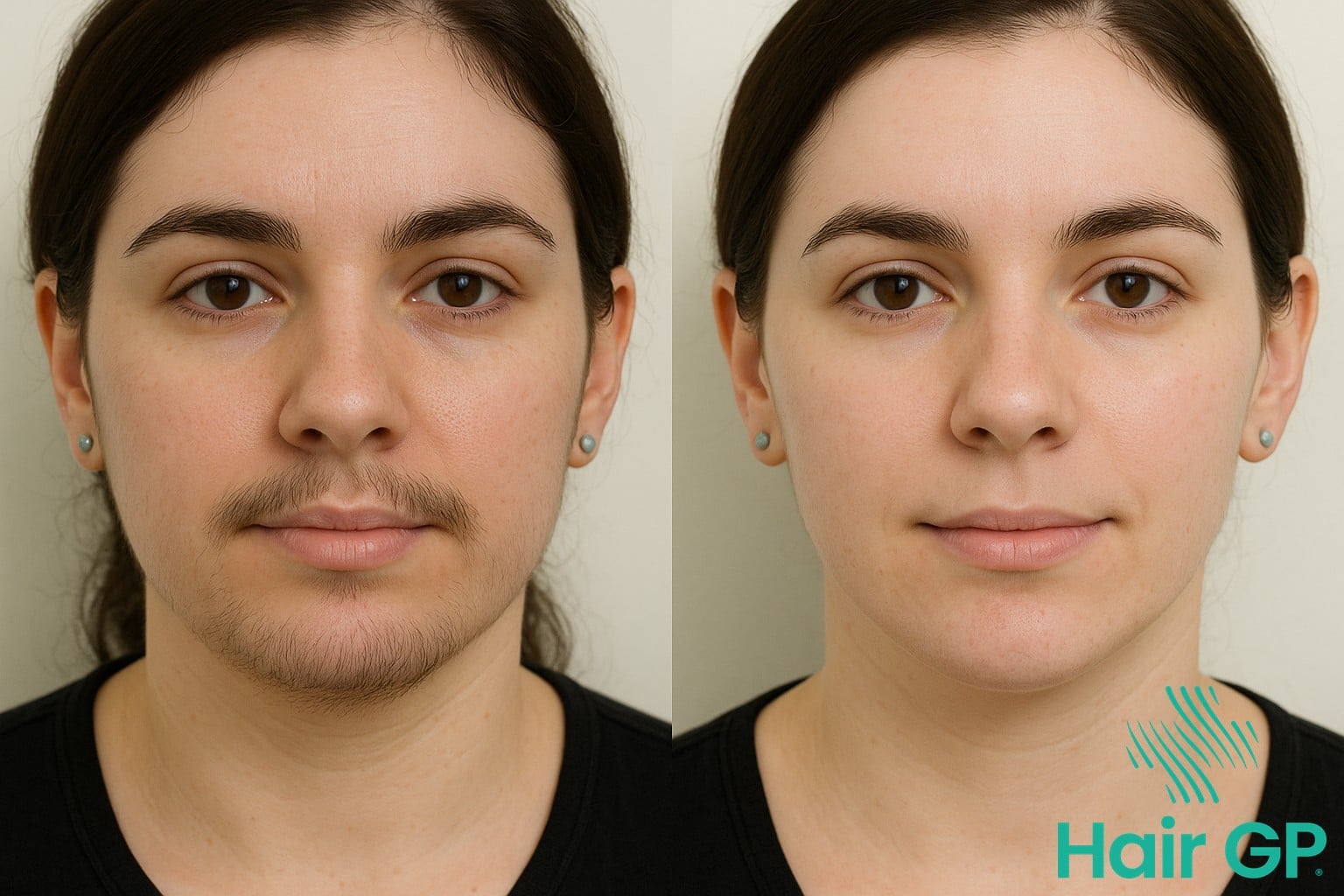
Laser Hair Removal vs Electrolysis for Hirsutism
When evaluating effective treatment options for hirsutism, both laser hair removal and electrolysis offer distinct advantages depending on individual circumstances. Laser treatment works optimally for those with dark hair and lighter skin tones, using targeted light energy to destroy follicles containing melanin. Studies demonstrate laser hair removal achieves 70-90% hair reduction after multiple sessions, making it an efficient choice for treating larger areas affected by hirsutism [3].
Electrolysis provides a more permanent solution regardless of hair colors or skin types, destroying follicles individually through electrical current. While time-intensive, this method works effectively on blonde, grey, or red hair that laser cannot target. For diverse skin tones, including darker complexions where laser treatment carries higher risk, electrolysis remains the safer option [4].
Cost considerations favour laser hair removal for extensive areas, typically requiring 6-8 sessions compared to potentially dozens of electrolysis appointments. However, electrolysis offers guaranteed permanent results whilst laser may need periodic maintenance. Treatment timelines vary significantly—laser sessions take minutes for large areas, whilst electrolysis requires hours. Ultimately, the optimal choice depends on hair colour, skin tone, affected area size, and budget constraints, with many patients benefiting from combining both approaches strategically.
Managing Hormonal Imbalances and Hair Growth
Managing hormonal imbalances requires understanding how elevated levels of androgens drive unwanted hair growth in hirsutism. When testosterone and other androgen levels exceed normal ranges—typically above 70 ng/dL for total testosterone in women[5]—they trigger terminal hair development in androgen-sensitive areas. Comprehensive hormone testing helps identify specific imbalances, often warranting endocrinologist referral for complex cases.
Anti androgen medications effectively regulate hormone levels by blocking androgen receptors or reducing production. Spironolactone, prescribed at 50-200mg daily, reduces free testosterone levels by approximately 30-50% within six months[6]. Combined oral contraceptives suppress ovarian androgen production whilst increasing sex hormone-binding globulin, thereby lowering free androgen levels. Lifestyle interventions complement medical treatment—weight loss of 5-10% can significantly improve insulin sensitivity and reduce testosterone in women with PCOS. Regular exercise, stress management, and anti-inflammatory diets help regulate hormone levels naturally. This multifaceted approach addresses both the symptoms and underlying hormonal imbalances, providing comprehensive management for hirsutism-related hair growth.
Other Hair Removal Methods: Temporary Solutions
Whilst electrolysis offers permanent results, many individuals initially explore temporary hair removal methods as interim management strategies. Shaving, waxing, and threading provide quick solutions but require constant repetition—often every few days for shaving or weekly for other methods. Depilatory creams dissolve hair at skin level, whilst bleaching merely disguises dark hair without actual removal.
These other hair removal methods present significant limitations for hirsutism management. Plucking and waxing can stimulate paradoxical hair growth in hormonal conditions, potentially worsening the problem. A comprehensive hair removal comparison chart typically reveals that temporary methods cost more over time than permanent solutions. Whilst useful during early electrolysis sessions, relying solely on shaving, waxing, or creams becomes exhausting and expensive. Cost analysis consistently demonstrates that permanent hair removal through electrolysis, though initially more expensive, proves economical long-term for managing persistent facial and body hair.
Treatment Timeline: What to Expect
Electrolysis for hirsutism requires multiple sessions over several months to achieve permanent results, with treatment timelines varying significantly based on individual factors. Understanding this time consuming process helps establish realistic expectations whilst your personalised treatment plan progresses from initial consultation through to maintenance phases.
Factors Affecting Treatment Duration
Several factors influence how long your treatment plan extends. Hair growth cycles determine session timing, as electrolysis only permanently destroys follicles during active growth phases. Treatment area size significantly impacts duration—whilst upper lip treatments may achieve optimal results within 12-18 months, larger areas like legs require considerably longer. Hormone stability proves crucial; unstable hormones can trigger new hair growth even during treatment, necessitating regular monitoring and potential plan adjustments.
Hair density and coarseness affect both session length and overall timeline. Dense, coarse hair typical of hirsutism requires more intensive treatment than fine hair. Most clients need weekly or fortnightly sessions initially, spacing appointments further apart as hair reduces. Future hair growth potential, particularly in hormonally active areas, may require periodic maintenance sessions even after completing primary treatment courses.
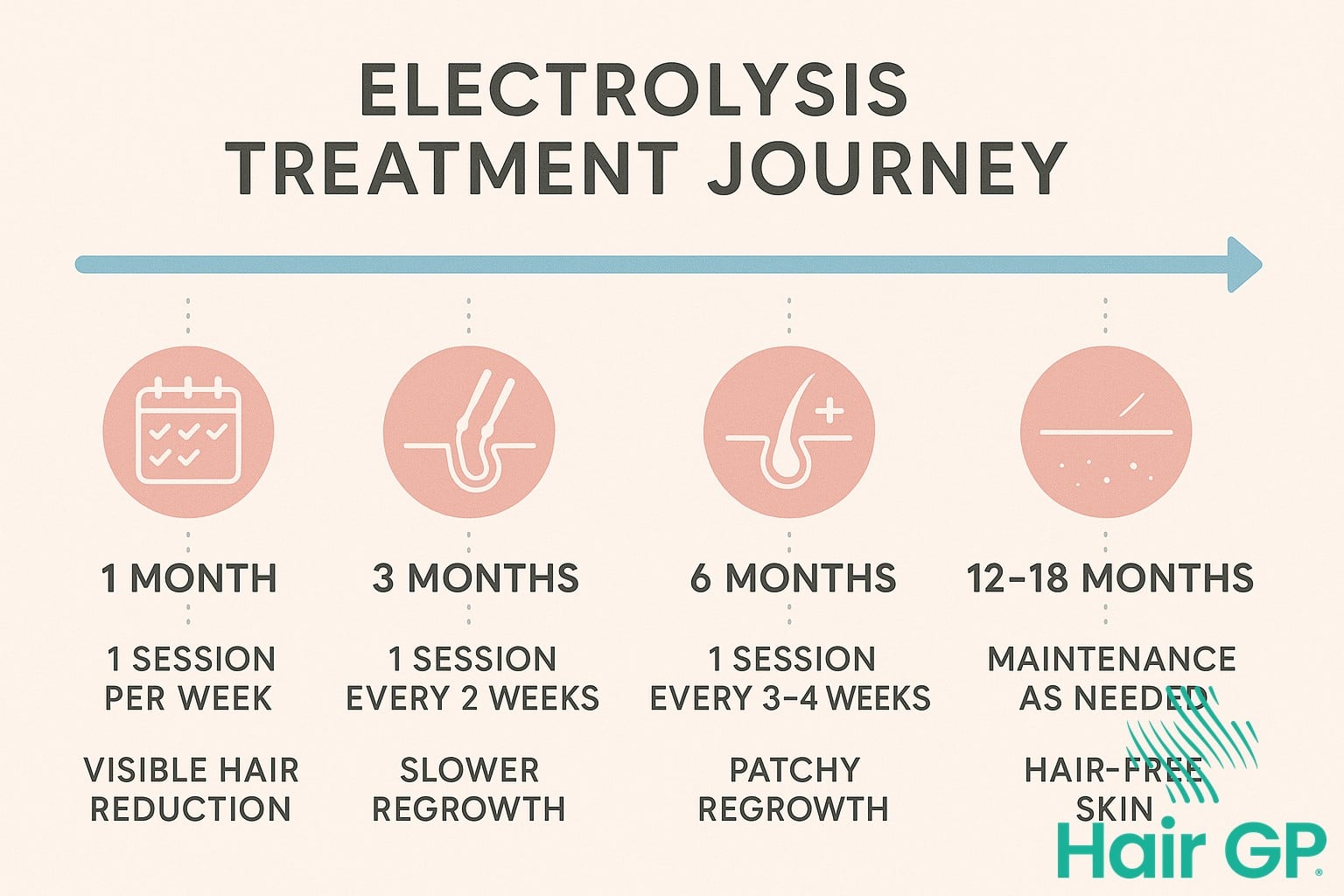
Building Confidence: The Emotional Journey
Living with unwanted hair growth profoundly affects self esteem and overall well being beyond physical appearance. The self consciousness experienced daily—from avoiding social situations to constantly worrying about visible hair—creates emotional exhaustion that impacts quality of life. Many individuals describe feeling trapped between societal expectations and their body’s natural processes, leading to isolation and anxiety.
Permanent hair removal offers more than cosmetic improvement; it provides psychological liberation. Patients consistently report a significant confidence boost after treatment, describing newfound self assurance in personal and professional settings. This transformation extends beyond appearance—the ability to feel confident without constant grooming rituals restores spontaneity and freedom. Support groups and mental health resources play vital roles in this journey, offering community understanding and validation. Many find that connecting with others facing similar challenges through online forums or local support networks accelerates emotional healing, reinforcing that seeking treatment represents self-care rather than vanity.
Conclusion
Living with hirsutism how electrolysis can restore confidence and control represents a transformative journey towards lasting self-assurance. As the only FDA-approved permanent solution for unwanted hair removal, electrolysis remains the gold standard for managing hirsutism effectively, regardless of hair colour, skin tone, or hormonal status.
Achieving optimal results requires more than standalone treatments. A comprehensive treatment plan integrating electrolysis with medical management addresses both the symptoms and underlying causes of excessive hair growth. This dual approach ensures sustainable outcomes whilst working to restore your confidence and quality of life.
Your journey towards permanent hair removal begins with two essential steps. First, schedule a consultation with a qualified, experienced electrologist who specialises in treating hirsutism. They’ll assess your specific needs and develop a personalised treatment schedule. Second, discuss an integrated approach with your healthcare provider to address any hormonal imbalances alongside your electrolysis sessions.
With commitment to treatment and proper professional guidance, electrolysis offers genuine hope for those seeking freedom from hirsutism’s physical and emotional impacts.
Frequently Asked Questions
Most patients describe electrolysis as a mild tingling or heat sensation. Topical numbing creams can be applied 30-60 minutes before treatment for sensitive areas like the upper lip. The discomfort is typically less than waxing and decreases as hair density reduces.
Treatment typically requires 12-18 sessions over 12-18 months. PCOS patients may need additional maintenance sessions every 3-6 months due to ongoing hormonal fluctuations. Session frequency starts weekly, then extends to monthly as hair reduces.
Yes, electrolysis permanently destroys treated follicles. However, hormonal conditions like PCOS can stimulate new follicles to produce hair. Combining electrolysis with hormone management provides the best long-term results.
Electrolysis works on all skin tones and hair colors by targeting follicles individually with electrical current. Laser requires contrast between skin and hair color, making it less effective for dark skin or light hair. Electrolysis is the gold standard for all skin types.
Depilatory creams provide only temporary relief lasting 3-7 days and can cause skin irritation with frequent use. For hirsutism management, electrolysis offers a permanent solution that’s more cost-effective long-term despite higher upfront investment.
References
- Wolf WM, Wattick RA, Kinkade ON, Olfert MD. Geographical Prevalence of Polycystic Ovary Syndrome as Determined by Region and Race/Ethnicity. Int J Environ Res Public Health. 2018;15(11):2589.
- Matheson E, Bain J. Hirsutism in Women. Am Fam Physician. 2019;100(3):168-175.
- Gan SD, Graber EM. Laser hair removal: a review. Dermatol Surg. 2013;39(6):823-838.
- Ibrahimi OA, Avram MM, Hanke CW, Kilmer SL, Anderson RR. Laser hair removal. Dermatol Ther. 2011;24(1):94-107.
- Sheehan MT. Polycystic Ovarian Syndrome: Diagnosis and Management. Clin Med Res. 2004;2(1):13-27.
- Barrionuevo P, Nabhan M, Altayar O, et al. Treatment Options for Hirsutism: A Systematic Review and Network Meta-Analysis. J Clin Endocrinol Metab. 2018;103(4):1258-1264.

